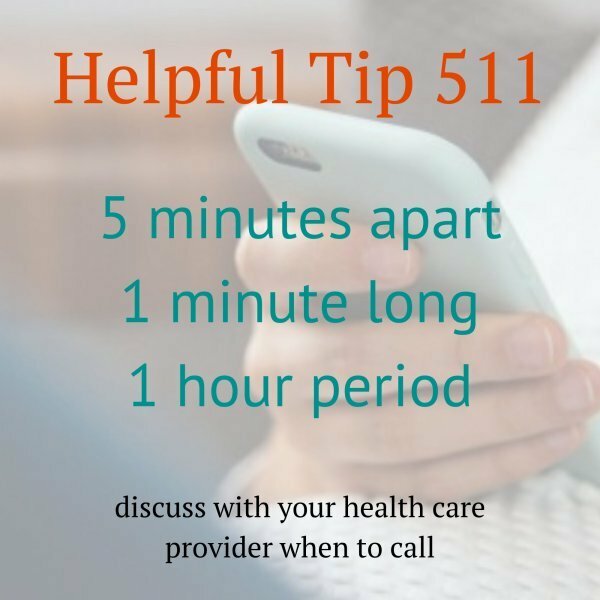Stages of Labor

First Stage
The first stage of labor is made up of three phases:
- early
- active
- transition
Early Labor
This stage tends to be the longest part and can last 12 hours or more. You can usually continue with normal activities during this time. Your contractions will mostly be mild and last less than a minute. You will have up to thirty minutes between contractions that will gradually come closer together and become more regular. These contractions will begin to efface (thin) and dilate (open) the cervix.
During this time, you want to:
- Breathe - breathe slow and easy, in and out through your note using a rhythmic pace.
- Relax - stress or fear can prolong labor. Focus on you breathing or relax in another way.
- Prepare - conserve your energy and eat small, light snacks. You can use upright labor positions to help keep labor progressing as well as to be comfortable. If you are tired, try to take a nap —now is the time. Start timing those contractions.

Active Labor
You should be headed to the hospital or birth center at this point and are in the most challenging phase of labor. Contractions are becoming progressively strong and longer, lasting 60 seconds or more and will be coming every three to five minutes. Your cervix will continue to dilate anywhere from four to seven centimeters. This phase can last from two to five hours or more on average.
- use comfort techniques and varying positions for comfort and to keep labor progressing
- you want to continue to stay relaxed during contractions
- breathe deeply in a comfortable and rhythmic pace - in through your nose and out through your mouth.
- go to the bathroom often
- if you are medicated, trying turning from side to side every half hour using a peanut ball between your legs.
- while many say they feel the contractions from their back moving to the abdomen, some also say they can feel the contractions in their thighs.
Second Stage
Delivery
Its time to push! You contractions are now every couple minutes and lasting between 60-90 seconds. They are partnered with a strong natural urge to push. Pushing is most effective when you follow the natural urge to bear down and relax when the urge subsides so you are resting between contractions.
As the baby starts crowning, their head is visible and you are very close to meeting your baby now. If the baby’s head is too large for your vaginal opening, your health care provider may decide to do an episiotomy. This is a surgical intervention to widen the opening.
As your baby appears, they may appear as a grayish blue color in the first few minutes. This will change to pink as they breathe. They may also have some vernix or blood on them, which they will clean off quickly.

Third Stage
Delivering the Placenta
After birth, your health care provider will clamp the umbilical cord and cut the cord. You can have your birth partner cut the cord. You can choose to have them delay clamping the cord if you like. You would want your health care team to know this ahead of time. There is research that shows it is beneficial to the baby by delaying the clamping Your baby will be left with a small blue/purple stump attached their belly button. It should fall off on its own within a couple weeks.
It’s now time to delivery the placenta, also known as the “afterbirth”. It typically takes only a few contractions for the placenta to separate from the uterine wall and be delivered. You may have some severe shaking and shivering, but this is normal. Your health care provider will perform a vaginal examination and check your perineum after delivery to repair any tears. If you had an episiotomy, it will be fixed as well during this time. Dissolvable stiches will be used, so there will not be anything to remove.
-l-l.jpg)
Fourth Stage
Recovery
You will spend the first couple of hours after your baby is born in your labor and delivery room before moving to your postpartum room. You will be able to have skin to skin contact, have family visit if you so choose and feed your baby during this time before you transition to your postpartum room.
Your health care team will be checking on your vitals signs frequently as well as check for vaginal bleeding and the firmness of your uterus. Postpartum bleeding will be at its heaviest at this point. You may experience some blood clotting or mild contractions as well and this is normal. This is due to the uterus shrinking back to its pre-pregnancy size.
Some of these pains may become more intense during breastfeeding. This is due to the fact that your body releases oxytocin during this time. In the end, this will actually help to control the bleeding.
(5)-l.jpg)
Want to find a Doula?
If you are in the Cincinnati or Dayton, Ohio area – look no further. Tamara Kankowski is a certified birth and postpartum doula as well as a childbirth educator. Tamara provides support to families everyday across the region. Tamara has an affordable birth doula package that includes personalized support during your pregnancy, labor and delivery that continues through your first eight weeks postpartum. Contact Tamara today to set up a free consultation!
If you are outside the area, DoulaMatch.net is a great resource to find doulas in your area or go online and see if there are Meet the Doula events near you!

